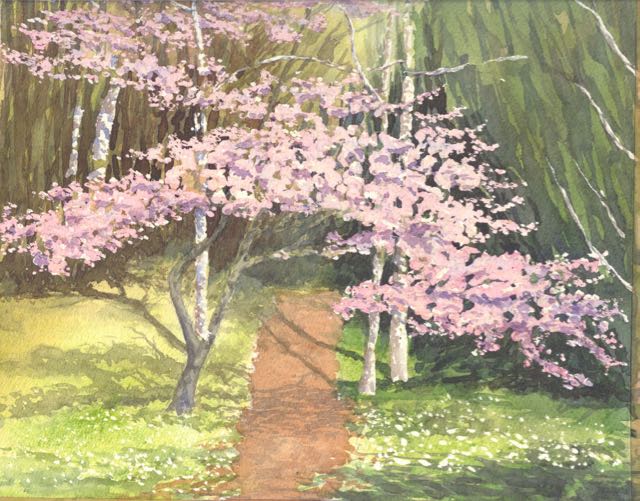
The Path Under Spring Flowers – Dave Baab
by Lynne Baab,
The first time I walked a labyrinth, there were about six other people walking it at the same time. I found myself bemused by the parallels between my walk in the labyrinth and my journey of faith. At some moments walking the labyrinth, a person would be beside me, walking on his or her own path right beside mine. Then our paths would diverge. I was reminded of close friends from certain points in my life, friends who shaped me and cared for me, but who have moved away and who I seldom see. Yes, we got to walk together for a while, but our journeys diverged.
That first labyrinth I walked was modeled after the labyrinth at Chartres, France. The path winds all over the place, and it feels like there’s no progress toward the center. In fact, there’s a section of the path furthest from the center. You walk on that outer rim, then take one turn, and boom, you’ve gotten to the center. This seemed so much like my life. Often I feel far from God, but my life takes a turn and suddenly God is present and real.
The time at the center of a labyrinth is quite special. You’ve walked a winding path to get there, and now you can stop for a minute to think and pray. Sometimes some other people are in the center with you. Maybe you don’t know them, but they know God too, so they are sisters and brothers. You are resting together in God’s presence, knowing you have to rejoin the path pretty soon and keep walking. That time at the center is like Sunday worship or other communal experiences of worship and prayer, a pause in the week to regroup with others before going back onto the journey. I may not know everyone who’s in church with me on Sunday, but together we are enjoying God’s presence in that pause from daily life.
A labyrinth is only one spiritual practice that evokes the notion of life as a journey. What are some of the other spiritual practices that help us experience the journey-like aspect of life with God?
- The Stations of the Cross. In the medieval period, very few people could travel to Jerusalem to walk the Via Dolorsa with Jesus. Walking and praying the Stations of the Cross helps everyday Christians to walk with Jesus to the cross.
- Praying while walking. I can’t tell you how many times I’ve been preoccupied, upset or angry about something. I set out on a walk, pondering and praying as I go, and when I get home, my perspective has completely changed. That one brief hour seems to expand to represent a long faith journey.
- A thankfulness list or journal. Writing down things we’re thankful for has at least two benefits. It helps us in the moment as we write, but it also helps later on when we refer back to the list. We can see the pattern of the way God has led us and blessed us on our journey.
- A prayer request list or journal. In the same was as described in #3, referring back to prayer requests, and checking them off when they’re answered, is a great way to see the pattern in our journey of faith.
- Pilgrimage. Whenever we take a physical journey for a spiritual purpose, that trip becomes a pilgrimage. We might visit a childhood home or school, a retreat center where God met us in a special way, or the setting of a significant life event. A pilgrimage is a physical journey that helps us see the journey God is leading us on in life.
- Examen. In this ancient prayer form, we are invited to look back over a period of time, perhaps one day, and look for God’s presence and also for the moments when we resisted God’s presence. Doing examen with some regularity enables us to see patterns in the places and times where we meet God and the places and times we resist God.
I wrote last month about the ways that the journey metaphor works so well to help us see moments and purpose in the life of faith. Many spiritual practices help us experience life as a journey.

1 comment
Hi Lynne in Dunedin from Ana Lisa in Auckland! This post has been a blessing and one I will remember. So much good material for reflection. I will have to read some of your other posts:) Thank you.